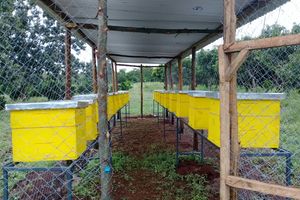Kenya’s honey industry on brink of collapse as bee populations decline

An apiculture demonstration farm in Ndaragua, Nyandarua County on May, 12, 2025.
What you need to know:
- Kenya produces about 17 million metric tonnes of honey annually, yet demand far exceeds supply at approximately 47 million metric tonnes.
As Kenya prepares to mark World Bee Day on May 20, experts are sounding the alarm: the country risks becoming a net importer of honey due to a sharp decline in bee populations driven by environmental degradation.
Despite a 14 per cent increase in beehives (from 1.2 million in 2019 to 1.6 million in 2023), according to the Kenya Bureau of Statistics, honey production is falling short of demand.
The Food and Agriculture Organisation notes that Kenya produces about 17 million metric tonnes of honey annually, yet demand far exceeds supply at approximately 47 million metric tonnes.
Experts say one of the best ways a country can measure its success story in environmental conservation is through bee populations and their products.
“There are no artificial methods of bee production and sustainability. The existence of bees entirely depends on the food environment, the forest cover, and natural vegetation. Therefore, riverbanks with preserved natural vegetation support bee populations. We observe more bee activity along rivers with undisturbed riparian land. You will even find bees making honey on tree trunks because the environment is conducive,” explains Nyandarua County Assistant Livestock Director John Gichuki.
He adds: “There is a direct relationship between bees, insects and the environment. The bee population is on the decline. Farmers are investing in beekeeping, but an increased number of beehives does not mean an increased population of bees.”
Mr Gichuki explains why a farmer might have many beehives but only a few actively colonised. He notes that successful beekeeping depends on the bee colony, not just the physical hives themselves. A farmer's success with beekeeping relies on having strong, healthy bee colonies that can produce honey and, more importantly, pollinate crops, which directly impacts food production.
He adds that uncontrolled agricultural activities contribute to environmental degradation, affecting bee and insect populations.
“The decline in natural vegetation due to increased agricultural activities has negatively impacted bee and insect populations by reducing their habitat and resources.”
Healthy ecosystem
A visit to Murata River in Ndaragua, Nyandarua County, is enough confirmation that bees and the environment are inseparable.
The community actively protects its rivers' riparian land, maintaining a healthy ecosystem through the preservation of old indigenous trees and vegetation along the river banks. This conservation effort also supports local beekeeping, allowing for sustained honey harvests by farmers
“I harvest honey twice in a year. Apart from making honey in beehives, the bees also make honey in holes of huge indigenous trees near the river,” says Mr Joseph Mwaura.
The destruction of natural vegetation for agricultural activities also compromises the medicinal and nutritional quality of natural honey.
“Foliage affects the quality of honey, with factors like pesticide exposure and the source of nectar and pollen playing key roles. Honey can be contaminated by pesticides used in crops, while honey from medicinal plants and natural vegetation can inherit those plants' medicinal properties,” says Food Scientist and Nyandarua Nutritional Director Paul Migwi.
Mr Mathew Ndebi, a beekeeper from Laikipia, says the massive destruction of forests for agricultural use has affected his apiculture activities.
He has 50 beehives that he harvests at least three times a year, getting an average of 10 kilos of honey from each beehive.
But times have changed.
His bees currently colonise only 20 hives, and honey production has fallen to once a year, averaging six kilos per hive.
“Irrigation farming is becoming popular in this area. We have many large-scale farmers clearing their farms and using chemicals, from herbicides to pest and disease control. I am witnessing a systematic drop in bee population and honey production,” says the farmer.
The situation is the same in Baringo County, which is among the top honey producers in the country.
According to statistics from the County Agriculture and Livestock Department, the devolced unit is struggling to increase honey production from the current 882 metric tonnes against a production potential of 10,000 metric tonnes.
“The annual potential of honey production is 10,000 metric tons and 1,000 metric tons for beeswax. But the current production is less than 10 per cent of the county’s potential,” reads the report.
Mr John Ndaire, a beekeeper in Nyandarua with over 400 beehives, admits that environmental factors are affecting bee population and production. He also attributes bee disease and pests to environmental degradation.
“Pests like varroa mites and diseases are becoming more common and reducing the bee population. This is affecting beekeepers. Deforestation, land clearing for agriculture, and charcoal production reduce suitable habitats and floral diversity for bees. That is why you will find stronger and healthier bee colonies in forest lands like Aberdare, where there is natural vegetation,” says Mr Ndaire.
Kenya also lacks clear policies and regulations relating to beekeeping.
Mr Ndaire urges the government to encourage environment-friendly land management, and inculcate a culture of protecting biodiversity that encourages diverse foraging habitats of bees.
Nyandarua Agriculture Executive Francis Miring’u says stakeholders in crop production and livestock keeping need to have short and long-term environment conservation approaches to protect the bee industry. He notes that the county’s Agriculture department is distributing sunflower seeds (nectar for bees) and promoting bee-friendly trees (sesbania, lupin and vetch).
“At the Nyandarua farm level, we supply farmers with foliage crops suitable for all livestock, including bees. The bee industry is very critical for food security, and the key to success in beekeeping is environmental conservation,” says Mr Miring’u.


